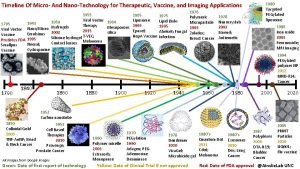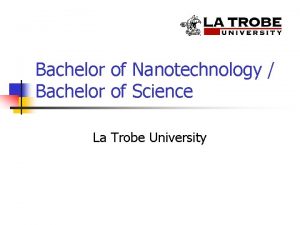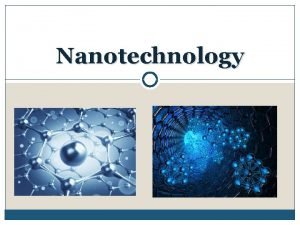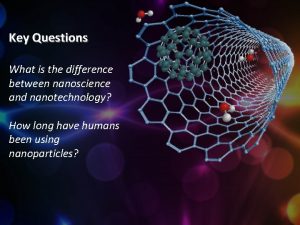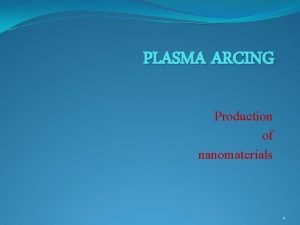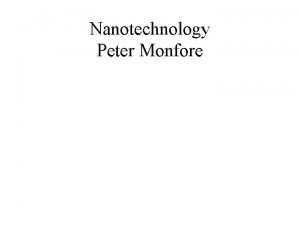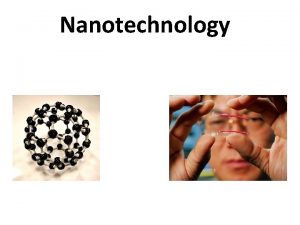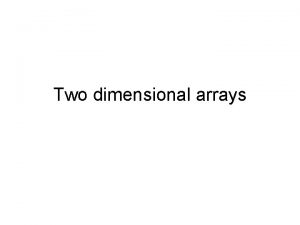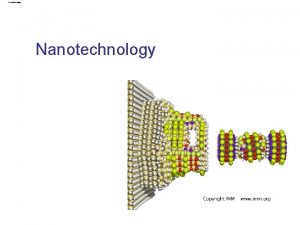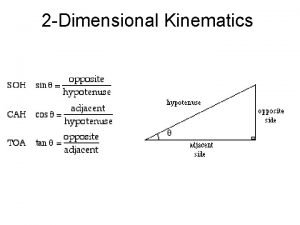Nanotechnology 25102016 1 2 dimensional systems with two













- Slides: 13

Nanotechnology 25/10/2016 1

2 -dimensional systems: with two dimensions over the nanometric range, these materials are constituted by large lamellae of nanometric thickness, often separated by pillars to avoid collapsing of the structure. Main applications of these materials are intercalation with other materials, Typical materials belonging to this group are nanostructured clays. 3 -dimensional systems: the materials of this group are constituted by complex structures of channels and/or cages interconnected to create a three-dimensional structure. They are mainly used as storage systems or as scaffolds to obtain porous materials in metal or carbon. Examples of this group are numerous three-dimensional structures in silicon or metal oxide. 25/10/2016 2

Classification of nanomaterials Depending on the dimension in which the size effect on the resultant property becomes apparent, the nanomaterials can be classified as zerodimensional (quantum dots) in which the movement of electrons is confined in all three dimensions, one-dimensional (quantum wires) in which the electrons can only move freely in the Xdirection, two-dimensional (thin films) in which case the free electron can move in the X-Y plane, or three dimensional (nanostructured material built of nanoparticles as building blocks) in which the free electron can move in the X, Y and Z directions. 25/10/2016 3

Figure (2) Density of states for 3 D, 2 D, 1 D, 0 D. 25/10/2016 4

Different Types of Nanostructures (NSs) All bulk materials can be transformed at nanoscale including polymers; metals, glass, semiconductors and ceramic etc. There are different classifications of NSs in nanotechnology, NSs usually classified by their geometrical properties. NSs usually consist of nanocages, nanocrystallites, nanobelts, nanoneedles, nanocomposites, nanofabrics, nanofibers, nanoflakes, nanoflowers, nanofoams, nanomeshes, nanoparticles, nanopillars, nanorings, nanorods, nanoshells, nanopowders, nanoclusters, nanowires, nanotubes, quantum dots. 25/10/2016 5

Types of Nanomaterials (NMs) For understanding, nanomaterials are designed into four types as follows: (i) Carbon based materials (ii) Metal based materials (iii) Dendrimers (iv) Composites (i) Carbon based materials: These are composed of carbon, taking the form of hollow spheres, ellipsoids or tubes. The spherical and ellipsoidal forms are referred as fullerenes, while cylindrical forms are called nanotubes. 25/10/2016 6

Figure (3)Carbon nanostructures 25/10/2016 7

Graphene is a crystalline allotrope of carbon with two- dimensional, atomic scale, hexagonal pattren. It is the basic structural element of other allotropes like graphite, fullerene, nanotubes, nanocones, etc. hence called mother of all carbon nanomaterials (Figure 4). Nowdays, it is commonly used in semiconductors, batteries, electronics, composite industries, and many more. 25/10/2016 8

Figure (4) Graphene and other carbon nanomaterials 25/10/2016 9

(i) Metal based materials: These include quantum dots, nanogold, nanosilver and metal oxides like Ti. O 2. A quantum dot is a closely packed semiconductor crystal comprised of hundreds or thousands of atoms, whose size is on the order of a few nanometers to a few hundred nanometers. (ii) Dendrimers: Dendrimers are repetitively branched molecules. The name comes from the Greek word ‘dendron’ (tree). These nanomaterials are nanosized polymers built from branched units. The surface of dendrimer has numerous chain ends, which can perform specific chemical functions. Dendrimers are used in molecular recognition, nanosensing, light harvesting, and optoelectrochemical devices. They may be useful for drug delivery. (iii) Composites: Composites are combination of nanoparticles with other nanoparticles or with larger. , bulk- type materials. Nanoparticles like nanosized clays are added to products (auto parts), packaging materials, etc. ) to enhance mechanical, thermal, and flame –retardant properties. 25/10/2016 10

Figure (5) Some types of nanomaterials 25/10/2016 11

Optical properties in Nanomaterials: Nanocrystalline systems have attracted much interest due to their novel optical properties, which differ remarkably from bulk crystals. Applications based on optical properties of nanomaterials include optical detector, sensor, imaging, display, solar cell, photocatalysis, photoelectrochemistry and biomedicine. 25/10/2016 12

Interaction of light with matter : The ‘colour’ of a material is a function of the interaction between the light and the object. If a material absorbs light of certain wavelengths, an observer will not see these colours in the reflected light. Only reflected wavelengths reach our eyes and this makes an object appear a certain colour. For example, leaves appear green because chlorophyll, which is a pigment, absorbs the blue and red colours of the spectrum and reflects the green. In general light (I) incident on a material can be transmitted (T), absorbed (A) or reflected (R): I = T+A+R As the size of the materials is reduced, scattering (S) of light can also contribute to its colour (or transparency). 25/10/2016 13
 A circular motion is one dimensional
A circular motion is one dimensional Timeline of nanotechnology
Timeline of nanotechnology What is nanotechnology
What is nanotechnology Nanotechnology for kids
Nanotechnology for kids Nanotechnology in golf
Nanotechnology in golf Nanotechnology fact or myth
Nanotechnology fact or myth Disadvantages of nanotechnology
Disadvantages of nanotechnology Disadvantage of nanotechnology
Disadvantage of nanotechnology Nanotechnology
Nanotechnology What is nanotechnology
What is nanotechnology Difference between nanoscience and nanotechnology
Difference between nanoscience and nanotechnology Conclusion of nanotechnology
Conclusion of nanotechnology Interpretations of moore's law assert that
Interpretations of moore's law assert that Plasma arcing
Plasma arcing

